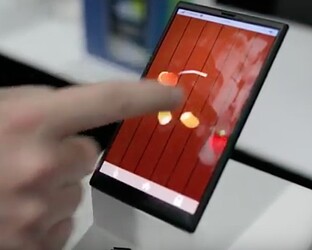Actually my goal was to produce some fast morse code messages to test people’s ability decipher them in a visually impaired interface, more later.
Javascript calls are available to operate your cell phone’s vibrator from a web page, some examples work on my cheap phone with Chrome browser, the most interesting ones don’t.
Here’s 19 different theme songs and a couple of Dream Theatre song rhythms on a 2013 HTML5 page.
(Seems like everyone had trouble with the old page)
FIXED , Try This Link with your Android (that “nebula-code” in the original source may have been an issue)
I apparently don’t have the imagination the author does, or perhaps my phone’s vibrator has too much inertia.
This could make for a new “Guess the Tune” game for various party settings,
A couple of simple examples that work on my phone.
Source code line for Morse code SOS, playing in about 1.5 seconds (too slow for a snappy interface):
if (navigator.vibrate) {
window.navigator.vibrate([100, 30, 100, 30, 100, 30, 200, 30, 200, 30, 200, 30, 100, 30, 100, 30, 100]);
The Mozilla API Page. With a compatibility chart.
Another example page that works for me.
The cell vibrator phone example was mainly intended for some initial testing.
This Pimorini Haptic Breakout (Vibrator) is the sort of tactile interface I had in mind for incorporating into a device. It’s linear actuator may well be able to produce must faster sequences.

The Pimoroni DRV2605L Linear Actuator Haptic Breakout £12.90 ($14 Digikey) uses a Texas Instruments chip that contains software and waveforms licensed from immersion (apparently a leader in the haptic feedback field) These linear transducers should be able to impart a greater variety of signals than a monotonous eccentric rotating mass (ERM) motors used in cell phones.
(123 effect waveform description table)
(This device is less complex than a tactile braille output with 6 separate contact points.)
. - - - - - -
The French company hap2U has developed some fascinating piezoelectric film haptic technology that is generations ahead. In one demonstration he describes being able to ‘feel’ the the android user interface and moving targets in a Fruit Ninja phone app.
A comprehensive 16 page examination of the technology by Engineers at IEEE TRANSACTIONS ON HAPTICS 2020
. - - - - - -
40 words per minute is a good speed for an amateur radio operator to receive. (at one time every license required a test at a much slower speed) the record holder more code decoder can accurately transcribes 140 words a minute.
The Morse code numbers are the slowest characters, using 5 pulses, 3-4 is more typical.
The Morse code numbers an interface might use. If one could recognize that at 10x the speed.
If digits only were needed in an interface, and the user preferably doesn’t know Morse code already. I worked out a faster, mostly binary code that could be used, 14 digits represented below. (2 - single pulse, 4 - 2 pulse and 8 - 3 pulse characters.) Commas are just separators.
. , -
.. , -. , .- , - -
... , -.. , ._. , _ _. , .._ , _._ , .- - , - - -
dot dash are commonly pronounced di da
Eclectic Bonus: an old school Vibroplex 2-paddle Ham radio key, these days they are simple black boxes.




 … but does work with vibrate switched on. Who’da thought!
… but does work with vibrate switched on. Who’da thought! 